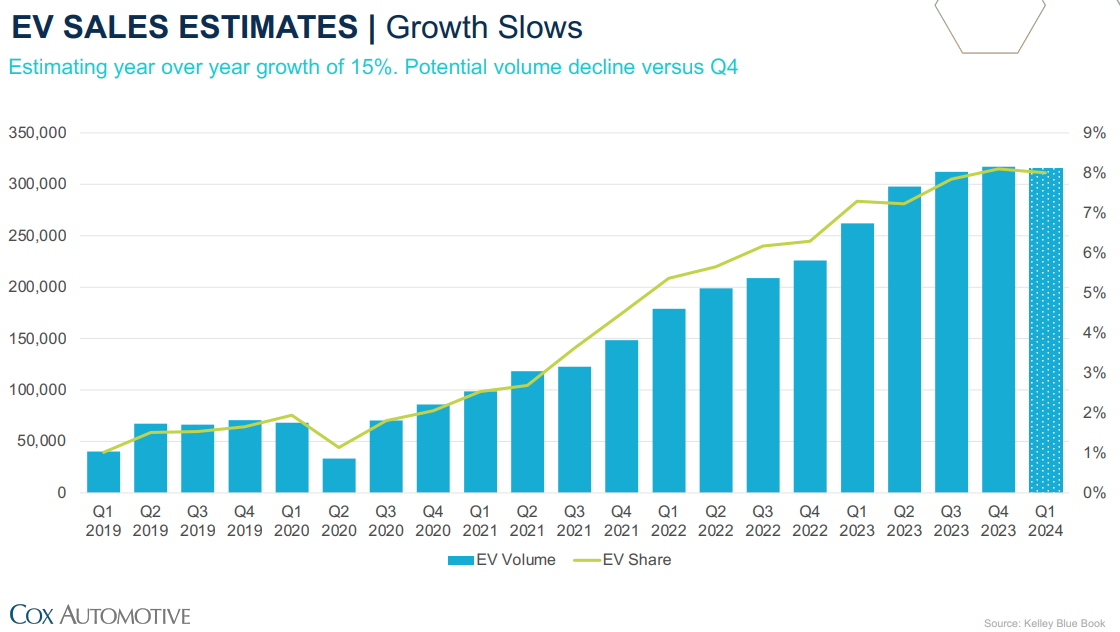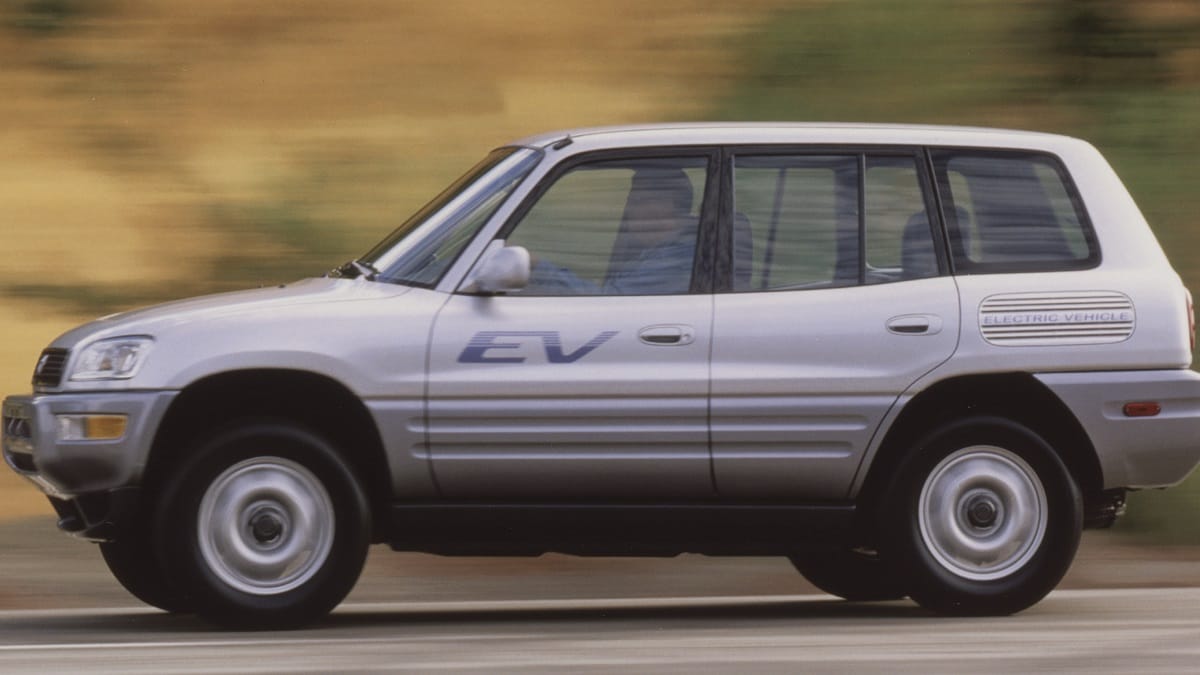This week, while doing some research on electric vehicle market share in the U.S. market, I stumbled upon an enlightening post by the U.S. Department of Energy. The post is titled, Timeline: History of the Electric Car. The site where this post is located is our government’s pro-clean-energy site where it has such headings as “Mapping America’s Clean Energy” and “Malarkey Corner, Combatting Misinformation” (About clean vehicles). I learned a lot from the educational post. Here is a quick snapshot of the facts that surprised me and may surprise you.
EVs Once Had About 33% Market Share In America
In February, Edmunds data shows that EVs earned about 6.5% of the American market. That was a slight decline from a bit less than 8% in Q4 of 2023. These market shares are of new vehicles sold in the U.S. market according to registration data. This was the modern high point of EV market share in the U.S. What I learned from the U.S. DOE’s post is that in the early 1900s, EVs captured about a third of the American market.

EVs Started almost 200 Years Ago
The first crude EVs were buggies intended to replace horses. They were first developed worldwide as early as 1828. At that time, America had 24 states, and Alaska was part of Russia.
First Electric Vehicle - 1832
According to the DOE post, the first electric vehicle in the sense we think of a vehicle and not a buggy, was built in 1832. This is not the first EV for practical use. That comes next on our list.
First Practical EV - 1870
The first practical electric vehicle was in 1870.
Electric Vehicle Advertisements Start in 1896
Many EVangelists in America today were frustrated by a lack of advertisements and promotion for EVs as they began the modern era. However, in 1896, EVs were being advertised. They emphasized that EVs were not that different from carriages.
EVs overlapped Horses In American Cities For About About 50 Years
One interesting fact is that horses and EVs overlapped in major American cities for about half a century. According to the NYC DEPARTMENT OF RECORDS & INFORMATION SERVICES, Horses were still used in great numbers when EVs were at their peak. Records show over 50,000 horses still being used in the city for transportation and commerce in 1920.
EVs were “Popular With Women” Prior to 1900
One interesting fact offered by the DOE is that prior to the end of the 1800s, EVs were “Popular with women.” The site says that this was due to EVs being quiet, easy to drive, and because they lacked pollutants.
EVs Reach Peak Market Share ~ 33% In Early 1900s
The peak of EV market share in America occurred between 1900 and 1910. Share at that time is estimated at around a third of all vehicles on the road.
Big Electricity Supported EVs
Thomas Edison supported electric vehicles. According to the DOE, he thought they were superior to gas-powered vehicles, and he turned his research might to improving batteries. Sound familiar?
Hybrids Overlapped EVs Over a Century Ago
In 1901, Ferdinand Porsche created the world’s first hybrid-electric car.
The Ford Model T Showed the Path Ahead - Gas-Powered Cars
The Model T was the vehicle that DOE credits with the beginning of the end of the EV in America. Ironically, it was the electric starter that made the vehicle viable for many.
EVs Decline - 1920 Through 1935
About 100 years after the first crude electric buggy, EVs have seen their arc completed. According to the DOE, by 1935, they “Had all but disappeared” in America.
 1996-1997 - The New Modern Era of EVs Begins
1996-1997 - The New Modern Era of EVs Begins
After an approximately 60-year hiatus from the American market, GM introduced its experimental EV1 in late 1996, and Toyota produced its first battery-electric RAV4 EV in 1997. GM determined that EVs are impractical and unprofitable based on their research and "killed" the electric car. Toyota found that electrification has big advantages, went on to produce a second generation of the RAV4 EV which leveraged Tesla’s battery advances, and dove deeply into electrified hybrids.
December of 2010 - Chevy Volt and Nissan Leaf Debut
The last month of 2010 was a turning point in America for EVs. GM began selling its Chevy Volt EREV and Nissan its Leaf BEV.
2012 - 2013 Second Generation EVs Begin
In 2012, Toyota introduced its second-generation battery-electric EV. By the end of 2013, there were sixteen plug-in vehicles on sale in America, led in volume by Nissan’s Leaf, which still had not broken 3,000 units in a year.
We assume you know the rest of the history of the EV. Tesla has begun to dominate, and every major brand has begun building EVs. The peak of the modern era of EVs happens in 2023 and levels at about 8% of the U.S. market share as we enter 2024. Watch for updates on EV market share for Q1 2024 in the coming days as data becomes available.
John Goreham is an experienced New England Motor Press Association member and expert vehicle tester. John completed an engineering program with a focus on electric vehicles, followed by two decades of work in high-tech, biopharma, and the automotive supply chain before becoming a news contributor. In addition to his eleven years of work at Torque News, John has published thousands of articles and reviews at American news outlets. He is known for offering unfiltered opinions on vehicle topics. You can connect with John on Linkedin. Please note that stories carrying John's by-line are never AI-generated, but he does employ Grammarly grammar and punctuation software when proofreading.
Top of Page Image Notes:
Source - Library of Congress Free Use Free Re-Use Page. Cress-Dale Photo Co, photographer. Detroit Electric auto on promotional tour through mountains from Seattle to Mt. Rainier / Cress-Dale Photo Co., Crary Bldg, Seattle. Mount Washington Rainier, 1919. [Seattle: Cress-Dale Photo Co., Crary Bldg] Photograph. https://www.loc.gov/item/2003653829/.
Image of 1997 RAV4 EV courtesy of Toyota. Chart showing EV sales in 2023 courtesy of Kelley Blue Book by Cox Automotive.






Comments
Technology has improved…
Permalink
Technology has improved exponentially since that time. Electric vehicles today are simply more energy efficient ,80% of energy input to wheels. ICE only gets 20% to wheels. Even someone like you should be able to understand this. It's so simple.
The flathead engine used to…
Permalink
The flathead engine used to dominate the Automotive market, and now it's completely extinct. Context matters. How can you compare alkaline and lead acid-powered electric vehicles to modern lithium-ion EVs?
Electric vehicles by fuel…
Permalink
Electric vehicles by fuel weight are very inefficient. Consider the average EV will only cover 240 miles with a full charge of its batteries. But those batteries weigh a thousand pounds. Now consider a internal combustion powered vehicle to cover those same 240 miles at 30mpg fuel weight is 48 pounds. Any perceived inefficiency of the internal combustion powered motor are more than offset by fuel weight.
Ridiculous meaningless…
Permalink
In reply to Electric vehicles by fuel… by John_Hud (not verified)
Ridiculous meaningless comparison
This is not about the…
Permalink
This is not about the electric car it's about the storage of electricity. The battery. So many products are becoming electric now that batteries have improved. Even renewables success relies on batteries. This is a battery revolution not a car one.
They didn’t have computers…
Permalink
They didn’t have computers to manage batteries back then. I’m pretty sure they did not understand that pinging an ion to create a magnetic field can create energy to turn them motor. A better analogy would be to compare a modern engine with fuel injectors to a steam engine.